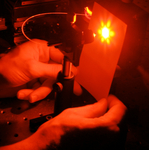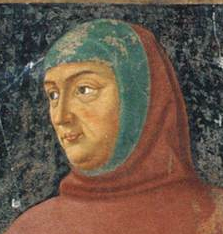 Even if you’ve got ultra deluxe high-bandwidth multigigabit Internet access, research by two UO physicists could make today’s information superhighway look like a bumpy backcountry road.
Even if you’ve got ultra deluxe high-bandwidth multigigabit Internet access, research by two UO physicists could make today’s information superhighway look like a bumpy backcountry road.
UO physicist Michael Raymer is helping pave the way for faster, more secure Web browsing through the quirkiness of quantum mechanics, which operates on the level of single electrons of matter and single photons of light. By focusing a dual-color burst of laser light onto a fiber-optic cable, Raymer and doctoral student Hayden McGuinness were able to change the color of a single photon—a crucial step toward quantum computing.
 The implications? If digital information can be stored and transmitted in a single electron and a single photon—rather than being stored in bits composed of many electrons and transmitted in light pulses containing many photons, as is currently the case—then quantum theory predicts a huge speedup of certain computer-intensive tasks, such as searching the Internet. Imagine “lightning-fast quantum Google,” said Raymer.
The implications? If digital information can be stored and transmitted in a single electron and a single photon—rather than being stored in bits composed of many electrons and transmitted in light pulses containing many photons, as is currently the case—then quantum theory predicts a huge speedup of certain computer-intensive tasks, such as searching the Internet. Imagine “lightning-fast quantum Google,” said Raymer.
Right: Graduate student Hayden McGuinness in the lab. Photos: Katie Campbell
The research by Raymer and McGuinness takes advantage of the fact that, at the level of single electrons and photons, quantum strangeness reigns. Think Einstein’s “spooky action at a distance,” the Heisenberg uncertainty principle and Schrödinger’s dead-or-alive cat (see sidebar). Because of this small-scale complexity, certain types of Internet transactions, such as searches, would become unthinkably fast and utterly hacker-proof.
One aspect of that quantum strangeness is wave-particle duality, which means that a photon of light possesses the properties of both a wave and a particle at the same time. This permits quantum bits to store values of both 0 and 1 simultaneously, unlike typical computer bits, which must have a value of either 0 or 1. This feature could not only significantly increase computational speed but could also render the quantum information safe from prying eyes. That’s because even the most careful observation of the quantum system would disturb its state, revealing the intrusion—another “spooky” effect.
One roadblock, however, is that quantum systems are based on the fact that electrons emit and absorb visible light. But existing fiber-optic cables are optimized to transmit infrared light. Raymer’s work potentially overcomes this obstacle.
In the next phase of their work, “the objective is to convert a single photon from the color that a common quantum memory will deal with into an infrared photon that communication fibers can transmit,” said Raymer, Knight Professor of Liberal Arts and Sciences. “At the other end, it has to be converted back into the original color to go into the receiving memory to be read properly.”
Raymer, who is dedicated to making science accessible to nonscientists (see Science Literacy story), recently published The Silicon Web: Physics for the Internet Age (Taylor and Francis, 2009) for the curious nonscientist who has little or no mathematics or physics background. The book covers the basics of mechanics, electromagnetism, waves, optics and quantum physics as well as the science behind advanced technologies such as lasers, fiber-optic communication and semiconductors.
“One can argue that scientific thought and methods have changed the course of human history as much as or more than anything else,” Raymer writes in the book’s preface. “To have a deeper understanding of where humanity is at present, it pays to study science and technology.”
— Eric Tucker
Sidebar: Quantum Strangeness Reigns
• Physicist Albert Einstein used the phrase “spooky action at a distance” to describe the quantum-mechanical phenomenon of quantum entanglement, in which the physical properties of two particles separated by vast distances remain strangely intertwined.
• In 1935, physicist Erwin Schrödinger devised a deliberately absurd thought experiment to illustrate the strangeness of quantum entanglement. In it, an unfortunate cat, trapped inside a box with a vial of poison that is randomly released or not, is simultaneously dead and alive until someone opens the box and observes it. Similarly, in the UO experiment, under the action of the dual laser burst in an optical fiber, a single photon of light can end up being both red and green at the same time until someone observes it, at which time it must “decide” which color to be.
• Formulated by physicist Werner Heisenberg in the 1920s, the quantum uncertainty principle states that the exact velocity and position of a subatomic particle can never be known simultaneously. For instance, measurement of the velocity of a particle will displace it by an unknown amount, invalidating the simultaneous measurement of its position. For light, measurement of the color of a photon will displace it in time by an unknown amount, invalidating the simultaneous measurement of its arrival time. Using this principle, it would be possible to tell whether or not an eavesdropper has tampered with the photon in an attempt to intercept a message being sent across the Internet.




 A new course will provide UO students with mobile smart phones and a mission: to build smart-phone apps.
A new course will provide UO students with mobile smart phones and a mission: to build smart-phone apps.
 Two CAS faculty members have been honored with the 2011 UO MLK Award.
Two CAS faculty members have been honored with the 2011 UO MLK Award. Petrarch is not only going digital at the UO, but musical as well.
Petrarch is not only going digital at the UO, but musical as well.